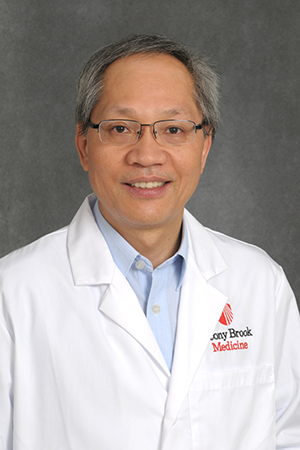
Cungui Mao, PhD
Professor, Department of Medicine,
Renaissance School of Medicine at Stony Brook University
Program Overview
My research program is to understand how alkaline ceramidases regulate the metabolism of bioactive sphingolipids and how this regulation in turn influences biological responses, including tumorigenesis, inflammation, angiogenesis, and stress responses.
It has been well established that sphingolipid metabolites, ceramide, sphingosine, and sphingosine-1-phosphate (S1P) act as signaling molecules that mediate various cellular responses. It is generally believed that ceramide and sphingosine mediate cell proliferation inhibition, differentiation, and apoptosis whereas S1P promotes cell proliferation and survival, so the relative cellular levels of these sphingolipids may determine a cell’s fate, to proliferate and survive or to undergo growth arrest and die. In addition, S1P has been implicated in various biological processes, such as cardiovascular development, angiogenesis, immunity, neurogenesis, and tumorigenesis. Because these bioactive lipids are interchangeable, regulation of a single step in their metabolic pathway may systematically alter their cellular levels, thus influencing various biological responses.
My group was the first to identify and clone three human alkaline ceramidases (ACER1, ACER2, and ACER3), the enzymes that catalyze the hydrolysis of ceramides into sphingosine, which in turn is phosphorylated to from S1P. As implied in their names, these enzymes have alkaline pH optima for their activity. Both ACER1 and ACER2 require calcium for their activity, and ACER3, which has basal activity, is significantly activated by calcium. They share a high degree of similarity in protein sequence but are distinct in substrate specificity, cellular localization, and tissue distribution. ACER1 hydrolyzes ceramides with unsaturated long or very long acyl chains, ACER3 ceramides with unsaturated long acyl chains, and ACER2 most mammalian ceramide species. ACER1 is localized to the endoplasmic reticulum (ER) whereas both ACER2 and ACER3 are localized to both the ER and Golgi complex. ACER1 is highly expressed in specific tissues, such as the skin, whereas both ACER2 and ACER3 are ubiquitously expressed. ACER3 is expressed at much higher levels in most tissues than ACER1 or ACER2. Our compelling data suggest that these ACER ceramidases have distinct roles in regulating the metabolism of bioactive sphingolipids and biological responses likely due to their distinct substrate specificity and tissue expression specificity.
Lab Members
Ruijuan Xu
Research Support Specialist
Education:
BS: 07/01/1985, Shanghai, China
MS: 07/01/1988, Shanghai, China
Project Description or Research Interest:
Roles of alkaline ceramidase 2 in cellular responses to p53 activation
Contact Info:
ruijuan.xu@stonybrook.edu

